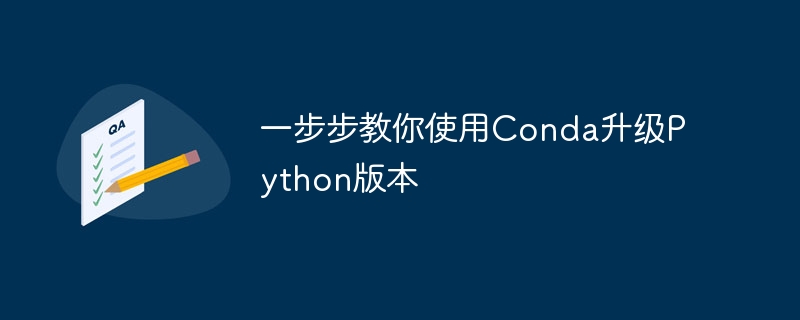Home >Backend Development >Python Tutorial >Step-by-step guide for updating your Python version using Conda
Step-by-step guide for updating your Python version using Conda
- 王林Original
- 2024-02-19 18:11:051055browse

Teach you step by step how to use Conda to upgrade the Python version, you need specific code examples
The cover comes from Unsplash (https://unsplash.com/)
Introduction
Python is a very popular programming language and is widely used in scientific computing, data analysis, machine learning and other fields. The Python community continues to launch new versions and features to provide developers with a better development experience. Therefore, it is very important to use the latest version of Python. This article will introduce in detail how to use Conda to upgrade the Python version and provide specific code examples.
Step 1: Install Conda
To use Conda to upgrade the Python version, you first need to install Conda. Conda is an open source software package management tool that can manage Python and its related package environments. You can download the Anaconda installation package suitable for your operating system from Anaconda's official website (https://www.anaconda.com/products/individual), and then follow the installation wizard to install it.
After the installation is complete, you can enter conda --version in the command line to verify whether Conda is installed successfully. If the version number of Conda is displayed, the installation is successful.
Step 2: Create a Python environment
Before upgrading Python, we need to create a new Python environment. The advantage of this is that you can isolate different versions of Python and avoid impact on the existing environment. You can create a Python environment through the following command:
conda create --name myenv python=3.8
The above command will create a Python environment named "myenv" and use Python 3.8 version. You can choose other versions to create an environment based on your own needs.
After the creation is completed, you can use the following command to activate the environment:
conda activate myenv
Step 3: Check the available Python versions
Before upgrading Python, let’s check it out first Available Python versions of Conda. This can be viewed using the following command:
conda search python
This will display all available Python versions. You can choose a suitable version according to your needs.
Step 4: Upgrade the Python version
After determining the Python version to be used, we can start upgrading Python. Use the following command to upgrade Python:
conda install python=3.9
The above command will install Python 3.9 version. You can choose other versions according to your needs.
After the upgrade is completed, you can use the following command to verify the Python version:
python --version
If the upgraded Python version number is displayed, the upgrade is successful.
Step 5: Verify the new Python environment
After upgrading Python, you can verify whether the new Python environment takes effect by running the following command:
python
This will open the Python interpretation device. You can use the following command to verify the Python version:
import sys print(sys.version)
If the new Python version number is displayed, the new Python environment has taken effect.
Conclusion
By using Conda, we can easily upgrade the Python version. First install Conda, then create a new Python environment, view the available Python versions, select and upgrade to the target version. Finally, verify the new Python environment to ensure the upgrade is successful.
I hope this article can help you successfully upgrade your Python version and enjoy the latest Python features and optimizations. If you have any questions or suggestions, please leave a message for discussion!
Reference
- Anaconda official website: https://www.anaconda.com/products/individual
- Conda documentation: https://docs.conda .io/
The above is the detailed content of Step-by-step guide for updating your Python version using Conda. For more information, please follow other related articles on the PHP Chinese website!

